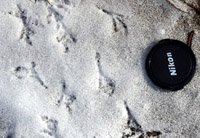Bird Tracks
There are several kinds of bird tracks, ranging in a wide variety of shapes and sizes. Some bird tracks have webbing, and some don't. Some have long toes and some have shorter toes. Though it is often very hard to tell what bird left a track, you can usually make a good guess! Some birds are more obvious than others.
How can you tell what kind of bird made a track? One way to tell what kind of bird might be responsible for a track is walking pattern.
Birds that spend most of their time on the ground walk and run, so their footprints alternate one after the other a lot like the way human tracks look.
Chickens are one kind of bird with tracks like this.
Perching birds spend most of their time in the trees. Small perching birds have very tiny feet. They have three toes facing forward, like the bigger birds, but their feet are much smaller altogether.
Many perching birds hop when they are on the ground. So, you will find their prints in pairs if you follow their trail.
Sparrows are perching birds, and have this kind of track.
Another way to figure out what bird left the track is to look around you. You can guess what bird left the trail by looking around to see what birds are active in the area, and by looking at the size of the tracks. You are likely to see larger tracks left by European starlings and American robins, and smaller tracks left by house sparrows, house finches, or black-capped chickadees.
Below are some of the bird tracks you might see in this area. (Click on any photo to see a larger version of the track.)
Pigeon & Mourning Dove
Pigeon & Mourning Dove
- 2 inches long
- alternating tracks
Pigeons are common birds to find around any city, so their tracks should be easy to locate. Look for them in dirt or sand. They have one long central toe and two slightly shorter toes on either side. There is also a shorter back toe that protrudes directly behind the middle toe from where they all meet. Their tracks are a little over 2 inches long from the tip of the front middle toe to the end of the back toe. Mourning doves will leave tracks that are similar to pigeon tracks.
Crow
Crow
- 2 to 3 inches long
- 4 inches apart
- alternating tracks
Crows are also common where humans live. They have one long central toe and two slightly shorter toes on either side. They also have one long toe protruding from behind the middle toe that is about the same length. The whole track is about 2 to 3 inches in length. It also may show small talon marks at the end of each toe.
When crows walk, they alternate their feet like humans. Sometimes they drag their toes and leave long lines in the dirt or mud. Their tracks are usually about 4 inches apart.
Gulls
Gulls
- 3 inches long
- 4 inches between
- alternating tracks
You might come across gull tracks. There are several different kinds of gulls, but their tracks mostly look the same. They have one long toe in the middle and two slightly shorter toes on either side. Webbing joins the space between their toes. Their center toe can be about 3 inches long. They leave about 4 inches between each track. Their tracks alternate, because they walk like humans on the ground.
Canada Goose
Canada Goose
- 4 inches long
- 6 inches between
- alternating tracks
You might see tracks of Canada geese. They have one long toe in the middle and two slightly shorter toes on either side. Webbing joins the space between their toes. Their footprint can be about 4 inches long. When these geese walk, they turn their feet in slightly, so the tracks might be pointing slightly towards each other. When they walk they usually leave about 6 inches between their tracks. Their tracks alternate because they walk like humans on the ground.
Ducks
Ducks
- alternating tracks
Duck tracks are similar to Canada geese but they are smaller. You can also usually see the webbing between the toes. Their tracks alternate, because they walk like humans on the ground.
Turkeys
Turkeys
- alternating tracks
Turkeys are related to chickens. They spend their time mainly walking through forested areas looking for seeds and fruits.
Plover
Plover
- alternating tracks
Plovers are shorebirds that walk along shorelines and other places looking for things to eat in the mud and among the plants. You can often see shorebird footprints, like these of a killdeer, on beaches or muddy shorelines. They move by running and walking, so their footprints alternate.
Blue Heron
Blue Heron
- alternating tracks
Blue herons are large birds that walk along shorelines and in water while searching for food.





